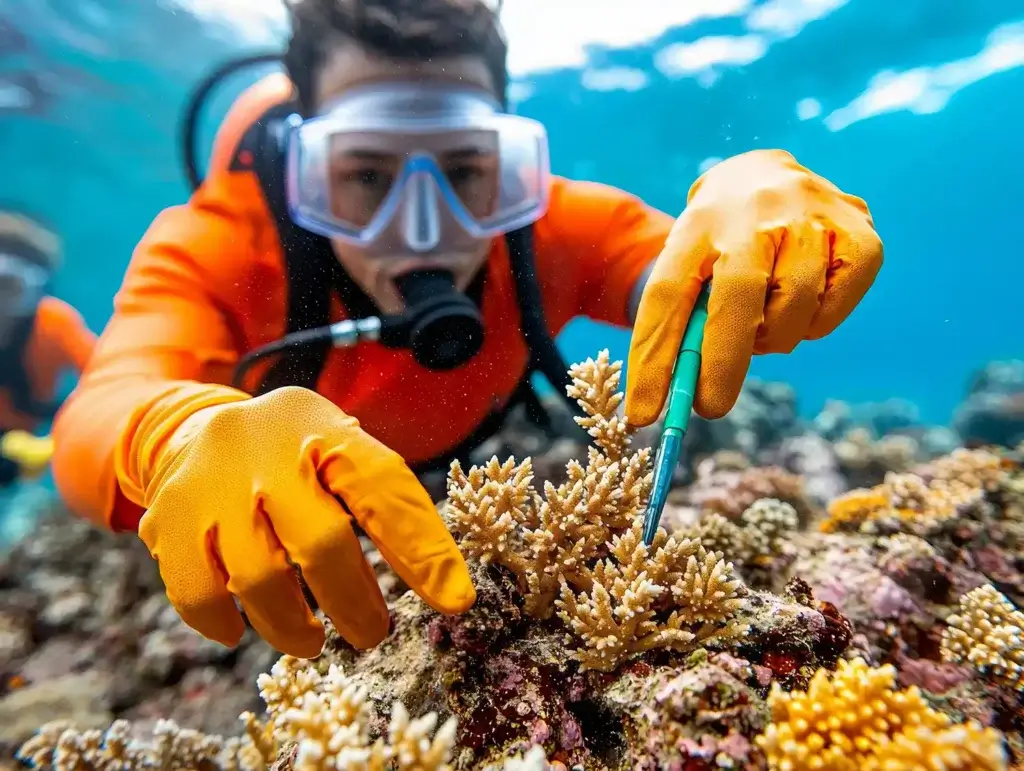The Science Behind Coral Bleaching
and Restoration Efforts

The Science Behind Coral Bleaching and Restoration Efforts
01
The Science Behind Coral Bleaching and Restoration Efforts
The Science Behind Coral Bleaching and Restoration Efforts
Coral reefs are among the most vibrant and vital ecosystems on Earth. Housing over 25% of marine species, these underwater rainforests support biodiversity, protect coastlines, and provide food and income for millions.
But rising ocean temperatures and human activity are causing coral bleaching — a phenomenon that is pushing reefs to the brink of collapse. Thankfully, science and conservation are working hand-in-hand to develop innovative coral reef restoration techniques to bring these ecosystems back to life.
This blog explores what coral bleaching is, why it occurs, its impact on marine life, and how restoration efforts are making a difference.
What Is Coral Bleaching and Why Does It Happen?
Coral bleaching is a stress response in corals caused primarily by rising ocean temperatures. Corals have a symbiotic relationship with microscopic algae called zooxanthellae, which provide them with nutrients and their vibrant color.
When corals are stressed due to heat, pollution, or acidification, they expel these algae, causing the coral to turn white or “bleach.” If stress continues, the coral can die.
Major Causes of Coral Bleaching:
- Ocean warming from climate change
- Pollution from sewage, sunscreen, and plastic
- Overexposure to sunlight
- Ocean acidification
Sediment runoff from coastal development
How Does Coral Bleaching Affect Marine Life?
Bleached corals are weakened and more susceptible to disease, often leading to reef degradation. This has a domino effect on marine biodiversity.
Key Impacts:
- Loss of habitat for thousands of marine species
- Decline in fish populations that depend on corals
- Disrupted breeding and feeding grounds
- Impact on local fishing economies
- Reduced natural coastal protection from storms
Healthy coral reef ecosystems act as nurseries for fish, absorb wave energy, and maintain a balanced marine food web. Their collapse could have devastating global consequences.
How Do Coral Reefs Recover After Bleaching Events?
Recovery depends on the severity and duration of the bleaching event, as well as the reef’s overall health.
Natural Recovery Process:
- Algae recolonization in coral tissues
- Resilient corals regrowing and reproducing
- Reduction in stress factors like pollution or overfishing
- Support from surrounding healthy reefs
However, natural recovery is often too slow. Without human intervention, many reefs fail to bounce back.

What Are Coral Reef Restoration Methods?
Coral reef restoration is the scientific process of helping degraded reefs recover and regain ecological function. Restoration projects involve both in-water and land-based efforts using advanced marine biology techniques.
Common Restoration Methods:
- Coral Gardening
- Fragments of resilient corals are grown in nurseries and transplanted back onto damaged reefs.
- Fragments of resilient corals are grown in nurseries and transplanted back onto damaged reefs.
- Microfragmentation
- Corals are broken into tiny pieces that grow faster and fuse together to form larger colonies.
- Corals are broken into tiny pieces that grow faster and fuse together to form larger colonies.
- Biorock Structures
- Electrified metal frames stimulate coral growth by enhancing mineral deposition.
- Electrified metal frames stimulate coral growth by enhancing mineral deposition.
- Assisted Evolution
- Scientists breed resilient corals to tolerate higher temperatures and acidification.
- Scientists breed resilient corals to tolerate higher temperatures and acidification.
- Artificial Reefs
- Man-made structures like concrete domes provide a surface for coral larvae to settle.
- Man-made structures like concrete domes provide a surface for coral larvae to settle.
Why Is Coral Reef Restoration Crucial?
With coral reefs facing extinction, restoration is no longer optional — it’s essential.
Reasons Restoration Matters:
- Protects marine biodiversity and endangered species
- Sustains local economies reliant on tourism and fishing
- Strengthens climate resilience by reducing wave damage
- Preserves the genetic diversity of coral species
Reverses damage caused by decades of human neglect
Global Coral Restoration Projects in Action
Several global initiatives are working to revive coral reefs:
- Coral Restoration Foundation (Florida Keys)
- Reef Resilience Network (Global)
- Mars Coral Reef Restoration Project (Indonesia)
- Great Barrier Reef Recovery Program (Australia)
These efforts have shown that with the right funding, research, and community engagement, coral reef restoration can succeed on a global scale.
What Is the Importance of Coral Reefs to Marine Biodiversity?
Coral reefs support an astonishing diversity of life. Though they cover less than 1% of the ocean floor, they house over a quarter of all marine species.
They also:
- Support 500 million people worldwide through food and jobs
- Serve as breeding and feeding grounds for fish and invertebrates
- Protect coastal communities from erosion and extreme weather
- Act as natural carbon sinks, helping combat climate change
Losing coral reefs means losing an irreplaceable pillar of Earth’s ecosystem.
FAQs
02
FAQs on Coral Bleaching and Restoration Efforts
What is coral bleaching?
Coral bleaching is a phenomenon that occurs when corals are stressed by environmental changes, especially ocean warming. This stress causes them to expel the symbiotic algae (zooxanthellae) living in their tissues, leading to a loss of color and nutrients. Prolonged bleaching can lead to coral death.
Why does coral bleaching happen?
Coral bleaching is primarily caused by rising sea temperatures due to climate change. Other factors include pollution, overexposure to sunlight, ocean acidification, and sediment runoff from coastal development. These stressors damage the coral-algae relationship, disrupting the coral reef ecosystem.
How does coral bleaching affect marine life?
Bleached coral reefs lose their structural complexity, leading to the loss of habitat for fish, crustaceans, and other marine biodiversity. This disrupts the entire ocean ecosystem, causing declines in fish populations and threatening the survival of species that depend on healthy reefs.
What is the importance of coral reefs to marine biodiversity?
Coral reefs support over 25% of all marine species, making them one of the most biodiverse ecosystems on Earth. They provide critical habitat, breeding grounds, and food sources for thousands of marine organisms, helping to maintain a balanced marine ecosystem.
How do coral reefs recover after bleaching events?
If the stressor (such as high temperatures) is removed, corals may recover by reabsorbing algae and regenerating tissues. Some resilient corals and neighboring healthy reefs can support recovery, but this process can take years without human intervention or coral restoration methods.
What are coral reef restoration methods?
Common coral reef restoration methods include:
- Coral gardening (growing fragments in nurseries)
- Microfragmentation (breaking corals into smaller pieces to accelerate growth)
- Biorock technology (using electric currents to promote mineral growth)
- Assisted evolution (breeding heat-resistant corals)
Artificial reefs (providing surfaces for coral attachment)
Why is coral reef restoration crucial?
Coral reef restoration is essential to preserve marine biodiversity, protect coastal communities, and mitigate climate change effects. Reefs are deteriorating rapidly, and restoration helps rehabilitate reef health, ensuring the survival of vital species and human economies.
What is coral stress and how does it relate to bleaching?
Coral stress is the biological response corals exhibit when exposed to environmental disturbances such as heat, pollution, or changes in salinity. When this stress becomes too intense or prolonged, it leads to coral bleaching as the coral expels its algae symbionts.
What is reef degradation?
Reef degradation refers to the declining health and structure of coral reefs due to bleaching, pollution, overfishing, and climate change. It results in a loss of reef biodiversity, reduced fish populations, and increased vulnerability to ocean acidification.
How does ocean warming contribute to coral bleaching?
Ocean warming raises water temperatures, exceeding the thermal tolerance of corals. This is the leading cause of mass coral bleaching events worldwide. Even a temperature increase of 1–2°C for several weeks can trigger widespread bleaching.
What are coral polyps and why are they important?
Coral polyps are tiny, soft-bodied organisms that build calcium carbonate skeletons — the foundation of coral reefs. They host algae that produce food through photosynthesis. When polyps expel algae during bleaching, they lose their main food source and begin to starve.
How do restoration projects support marine conservation?
Coral restoration projects strengthen marine conservation by reviving reef ecosystems, enhancing biodiversity, and educating communities about sustainable ocean stewardship. These projects also act as testbeds for scientific innovation in marine habitat recovery.
What are resilient corals?
Resilient corals are species or genotypes that can withstand higher temperatures, pollution, or acidification. They play a key role in restoration efforts, as scientists use them to repopulate degraded reefs and build long-term reef resistance to climate stressors.
Where are coral reef restoration efforts taking place?
Global restoration efforts are underway in regions such as:
- Florida Keys (USA) – Coral Restoration Foundation
- Great Barrier Reef (Australia) – Reef Restoration and Adaptation Program
- Indonesia – Mars Coral Reef Restoration Project
Caribbean & Southeast Asia – Multiple community-based initiatives
How does coral rehabilitation contribute to reef health?
Coral rehabilitation helps restore the structural complexity and biological function of reefs. By reintroducing healthy coral fragments and reducing local stressors, these projects improve reef health, making ecosystems more stable and resilient to future climate events.
Why is marine conservation important for coral reefs?
Marine conservation helps protect coral reefs from overfishing, pollution, and human activities. It enforces sustainable practices, supports restoration efforts, and ensures reefs continue to provide essential ecological services for future generations.
The ocean’s heartbeat is weakening, and coral bleaching is a stark warning. But with science, innovation, and community action, we have a chance to restore these underwater wonders.
From understanding coral bleaching to embracing cutting-edge coral reef restoration techniques, every step counts. Our oceans are resilient, but only if we give them the chance to heal.
Let’s commit to protecting our reefs, not just because they’re beautiful, but because our planet depends on them.
03
Connect With Us
CONNECT WITH US
Partner with SeasYourDreams.org to create lasting impact. Together, we fund ocean research, inspire through STEM education, and grant medical wishes. Join a network of change makers committed to sustainability, innovation, and compassion. Collaborate with us to amplify efforts and transform lives. Let’s make waves of positive change—partner with us today!
04
INFO
© 2025 | SeasYourDreams. All rights reserved.
